Photo Corners headlinesarchivemikepasini.com
![]()
A S C R A P B O O K O F S O L U T I O N S F O R T H E P H O T O G R A P H E R
![]()
Reviews of photography products that enhance the enjoyment of taking pictures. Published frequently but irregularly.
A DIY Camera Finder


6 September 2013
You remember them, perhaps fondly. They had these big button panels in lovely colors that asked you if you knew what you wanted or not and if you were buying new or upgrading your digital camera. You tapped into their expertise enthusiastically, hoping to find your dream on sale at the end.
Where'd they all go?
It's a testament to the tortuous decision making tree any camera buyer has to navigate for one thing. But even more, we suspect, it was a Sisyphean task to maintain the data, updating it with new models and culling the discontinued ones.
DATA | Back to Contents
We were never responsible for data entry on a camera database but when we had access to one, we were always astonished at how poorly maintained it was. We'd run reports on it to answer a reader question only to find a lot of missing data or incorrectly formatted (and hence useless) data.

Camera Finder. Looks kind of like a shell game.
The same is true of the various data feeds from price aggregators. There's a lot of garbage in them. The software we wrote to parse them was constantly being updated to handle incorrect or misleading product names.
A hot model, for example, wouldn't be for sale and we'd all scream, "Where is it?" It would be in the feed but with a typo in the name.
The aggregator would explain that's what they got from the vendor (the store selling the thing) or the manufacturer or.... But the truth is that no one was paying the data entry clerks to be accurate or the programmers to help them be accurate. They just wanted them to enter the listings. Of things they often had no clue about so even the obvious error wasn't very obvious.
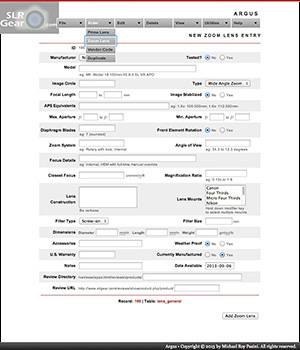
Data Entry Screen. This one is just for zoom lenses (and yes it does verify input and even provide popups for some fields). Just imagine what a camera entry screen is like.
Because the software didn't verify the entries, garbage (utter nonsense) ended up in the database with frightening regularity. And you know what they say about garbage in.
STILL | Back to Contents
So don't expect a revival of those old systems any time soon. And if you see one, don't trust it.
Which doesn't exactly help you find your next camera or printer or scanner. How exactly are you supposed to do that?
Our solution here has been to post the best products we've found on our Best Products page, which is unabashedly modeled on The Wirecutter. When you purchase from those links, you also help support our (non-Sisyphean) efforts.
But that doesn't take into account one essential factor: you.
Your needs may or may not be covered by the options presented on a Best Of page. But someone has to listen to those needs. And that someone has to have not only some expertise but some familiarity with the options. So, you know, their time is not cheap.
If we had a nickle for every time one of the experts we knew proclaimed they had no time to give product recommendations, we'd be sitting in a different kind of chair by now. A throne.
That's one reason those camera finders came into being. Except they fail at that "familiarity" requirement when their databases are not properly maintained.
DIY PROJECT | Back to Contents
So this becomes a do-it-yourself project. And this article is here to help you formulate the questions. Although we hasten to point out that our Subscribers get our undivided attention with free tech support. Just so you know.
Your Budget
There are three classes of digital camera and they run from about $150 to $10,000. There's quite a bit of overlap, though.
Very roughly speaking, the compact digicam that's just a step up from a smartphone runs from $150 to $500 roughly. The lightweight mirrorless camera that adds interchangeable lenses to the game goes from about $500 to $1,500. And the dSLR that knows no limits goes from roughly $600 to $10,000. You'll never find a good deal at the low end of these, just as you won't at the high end. The truth is, you know, always somewhere in the middle.
But what your budget really defines is the size of your sensor (which is not the same thing as the number of megapixels). The larger the sensor real estate (really the size), the better the image the camera captures. And guess what? Those three classes represent, for the most part, sensor sizes. Digicams have puny sensors, mirrorless cameras have bigger ones (if not large) but dSLRs have the largest.
Once you know which sensor class you're shopping for, the question changes. Let's look at a small budget path first.
Small Budget Digicam
Congratulate yourself. You've escaped the smartphone world with a zoom lens, a flash that can actually illuminate something and some built-in smarts. You've probably lost the ability to instantly share images, but there are solutions to that if it bothers you.
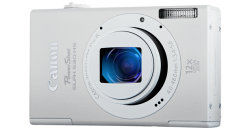
Canon ELPH. Compact PowerShots are not just inexpensive but a delight to use.
The question now is one of features:
- Is a 3x zoom good enough or do your crave a 30x zoom? How about settling for 10x zoom? And what focal length are we starting from here anyway?
- Do you want GPS? How well implemented is GPS? Can you turn it off easily? Can you use it to map your location? Your shots?
- Does water resistance add anything?
- Are you going to travel much with this (ever have to check your carry-on)?
- How well implemented is the panorama capture? Can you just sweep the camera over the scene and, a moment later, see the stitched image on the LCD?
This class also offers a lot of built-in editing features, none of which we find compelling. Because the only place these images tend to go from the camera is to your computer where they can enjoy serious makeovers.
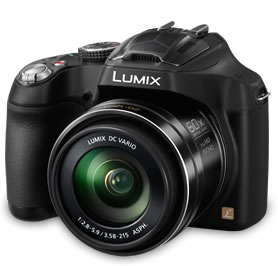
Panasonic FZ72. A megazoom makes extraordinary reach, like this FZ72's 60x optical zoom, affordable.
Another non-compelling feature is Manual control. It's almost always absent (there may be an M on the dial but it doesn't mean what you think) because the small sensor really doesn't admit to much variation in the lens aperture. Strange but true. So these are essentially automatic cameras.
Top brands are Canon PowerShots and the Panasonic LX-series. On the second tier you'll find Sony and Nikon Coolpix. Nobody else is really worth thinking about. And that probably goes for the second tier, too.
Nope, Not Small Budget Digicam
If you want more out of your camera than that, you're looking at the mirrorless and dSLR classes. Or you would be if suddenly the question hadn't shifted.
Once you start looking at cameras that feature interchangeable lenses (not all of them in this class do, but play along), you are really shopping for lenses not camera bodies. The lenses you select will last a lifetime. Yours. The camera bodies will come and go every couple of years (months, in some cases) or so.
You are, in short, building a system whose backbone is your lens collection. You add to that whatever you need. Like a camera body. Bodies are really accessories at this level. You'll replace them every now and then to keep using your favorite lenses.
The little secret we're revealing here is that photography is more about the lenses than the cameras. It's obvious whenever someone points it out.
Optics
You have quite a lot to choose from when it comes to optics. It really deserves a decision tree of its own. And if you haven't had much experience with photography already, it can be daunting. But it doesn't have to be. Here's how to think about it.
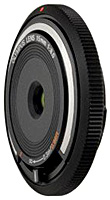
Olympus Pancake. A 15mm f8.0 body cap lens which delivers a 30mm 35mm equivalent.
Focal Length
The focal length of a lens tells you what it can see. A wide angle focal length (say 24mm to 35mm) sees more than what you normally take in with your own eyes, which is great for squeezing as much of the room as possible into the picture. A normal focal length (50mm) lens shows you pretty much what your eyes notice. And a telephoto focal length (80mm to 600mm, roughly) lens gets you a lot closer than where you're standing.
But you don't have to choose a single focal length (or what we call a prime lens). You can opt for a zoom lens that ranges from wide angle to telephoto.
Focal lengths are usually expressed as 35mm equivalents or the focal length a 35mm camera lens would be. So you might have an 18-200mm 35mm equivalent zoom but its real focal length would depend on the size of its sensor and, those varying all over the place, meaningless.
We all understand 35mm focal lengths, so everything (like the focal lengths in the first paragraph of this section) is translated to that scale.
Zoom
Zoom lenses are often described as 3x or 10x or so. That represents their reach from wide angle. So a 10x zoom that goes as wide as 24mm will reach as far as 240mm at telephoto while a 5x zoom that also starts at 24mm will only make it to 120mm.
A 10x zoom that starts at 35mm, though, makes it to 350mm. So starting at less than full wide angle can get you closer even though the zoom power is the same.
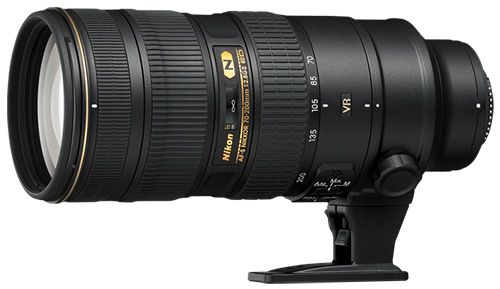
Nikon 70-200mm Zoom. At this size, you mount the lens on the tripod, not the camera body.
Speed
Lenses are also referred to as fast or slow, which reflects their widest aperture. An f1.2 aperture is considered fast. An f/4.5 aperture is considered slow.
A zoom lens usually (but not always if you have the cash) changes its maximum aperture as you move from wide angle to telephoto. What may be fast at wide angle can be slow at telephoto as the barrel of the lens extends. Those lenses are referred to as being something like f3.5-4.5, for example. For a good deal more money, you can find a constant aperture zoom that stays at f2.8 throughout its range or, for a bit less money, at f4.
Macro
All lenses have a close focus limit. You can only get so close to your subject before no amount of fiddling with focus will make the images sharp. At telephoto focal lengths, that's a few feet away. At wide angle, maybe just a few inches.
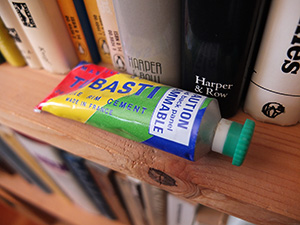
Macro Shot. From a Fujifilm X10 showing a very shallow depth of field at f2.0, 1/140 second and ISO 400.
Lenses also have a magnification ratio indicating how small the capture is compared to the size of the real thing. A macro lens, for example, might manage a 1:1 ratio of capture to reality. Like to shoot things you can't usually notice? Look for a macro.
Stabilization
Holding a telephoto focal length steady can be impossible beyond 200mm. Lenses often incorporate image stabilization to help with that. Image stabilization is also useful in low light when shutter speeds are slow, so some camera bodies include the feature. That means you don't have to have it in every lens you buy.
A mirrorless system will use much smaller and lighter lenses than a dSLR. So if you're carrying three bags around already, you may not survive a camera bag with a dSLR and two lenses. But a mirrorless with a 3x zoom might fit in your purse or manbag.
Brands
Modern lenses tend to be safe bets, especially at f8, but there are tradeoffs lens designers make in every lens they design. We've listed the factors above. Just remember there's no free lunch. You won't find an 18-200mm f1.2 image stabilized zoom that is sharp corner to corner throughout its range and aperture settings.
The major manufacturers are major because their glass is great. Nikon, Canon, Pentax, Olympus, Sony, to name a few, all boast excellent optics. Zeiss, Sigma and Tamron are third-party lens manufacturers who often offer a unique option.
There are also specialty lens makers like Lensbaby that provide even more fun.
Bodies
Photography may be more about the lenses than the cameras, but the sensor size you want to invest in determines what lenses are available. If you pass on the tempting megazoom digicam and its smaller cousins, you're down to three options: mirrorless, sub-frame dSLRs and full-frame dSLRs. The cost of the glass goes up with each, too, mirrorless being significantly less expensive than full-frame dSLR glass.

Olympus OM-D EM-5. A camera of the year last year, this mirrorless doesn't give up much to its dSLR relatives.
The salient facts follow:
- Mirrorless is smaller. You can drop one in a purse or fit a small camera bag with more options than a roll-on full of dSLR gear.
- Sub-frame dSLRs use a smaller sensor than a full-frame dSLR but a larger sensor than mirrorless. They can often mount full-frame lenses (film or digital) but they only capture a central crop of the image. A focal length modifier indicates how much. On a Nikon sub-frame, for example, a 1.5 focal length modified means a 50mm lens will crop like 75mm lens and 35mm lens will crop much like the 50mm. Lenses made for sub-frame cameras are smaller and less expensive than full-frame lenses even though they have the same mount because they just don't need to cover as much capture area.
- Full-frame dSLRs use the same capture area as a 35mm film frame. So the normal focal length of a lens is what you actually capture. Which makes it hard to achieve the sort of reach a megazoom digicam can without filing for bankruptcy. They tend, however, to have the best low-light performance and image quality.
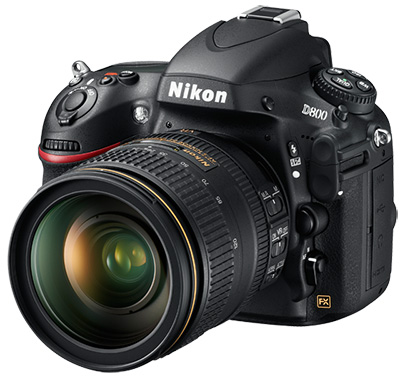
Nikon D800. A full-frame top-of-the-line dSLR with a pro build that takes, um, two hands to lift.
There is one other aspect to keep in mind when shopping for bodies. Some companies make a distinction between professional build and amateur build. And amateur build will use plastic where the pro build relies on, say, magnesium.
This isn't always simply a matter of asking whether you drop your camera a lot, though. Some professional affiliations require two pro bodies to join, for example. And your homeowners insurance may not cover a pro body but have no problem with an amateur one.
Mirrorless Brands
Among the mirrorless brands to consider are Olympus Pen, Panasonic, Sony NEX and Fujifilm X. This is a fast moving field, though, so don't neglect new players like Samsung.
dSLR Brands
The top system cameras have always been Canon and Nikon. Their dSLRs can be extended with a wide range of lenses and accessories (including strobes) that it really takes a lifetime to master. Nikon's wireless lighting system is more sophisticated than Canon's, otherwise it just depends on what you've been smoking.
Sony is a player here too but has a smaller system. Fewer lenses and accessories. You may be amused to find their sensor in your other-brand camera, though.
This is not a fast moving field. But you can also score some great deals on dSLRs made by Pentax (which also has a substantial system behind it and some great lenses)
CONCLUSION | Back to Contents
If nothing else, this DIY Camera Finder, focusing on optics over camera bodies, blazes a different path through the acquisition thicket than the stuff you used to find online.
That may seem to discount the many features only available on one body or another. Or even an evaluation of who does what better. You know, the sort of thing most camera reviews busy themselves with.
But it isn't a contest.
It's an activity. And if you aren't out there taking photos or tweaking them in your image editing software, you aren't a photographer.
We hope this article puts things in perspective and provides a simple way to evaluate what's available as well as what's just been announced. That should get you over the acquisition hump and into the field where you enjoy capturing images whose beauty is always a pleasure to behold.